
Kingfisher
Kingfisher
Kingfisher
Kingfishers are birds that are familiar to us humans and can be observed in the human sphere of life. Unlike sparrows and crows, kingfishers with a bright body are also popular birds among connoisseurs. Did you know that such kingfishers are actually deeply related to the gemstone jade? Did you know that although it has a bright blue body, it is not actually blue? In this article, I would like to approach the further charm of kingfishers.
Kingfisher Basic Infomation
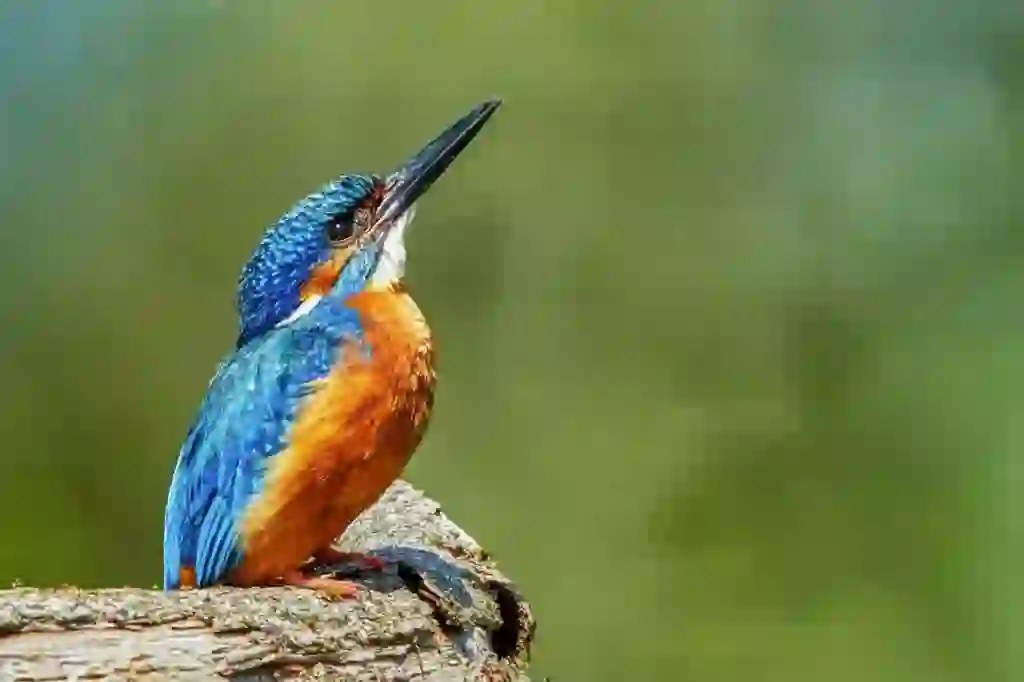
Coraciiformes-Alcedinidae-Kngfisher genus.
It is sometimes called "kingfisher" to refer to the entire kingfisher family, but in this article we will introduce a single species of kingfisher classified in the kingfisher genus.
Length:About 15-20cm.
Beak:About 3.3-4.3cm.
Wing opening length:About 24-25cm.
The total length is larger than the sparrow, but without a long beak the body size is about the same.
It has a distinctive bright blue body, and also has white, orange, and red colors on its body. Its beauty is so captivating that it catches the eye of anyone who sees it. It is sometimes called "the jewel of the stream" and you can understand why.
Its long beak is also a characteristic feature of the kingfisher, and it helps to distinguish the sexes. The male’s beak is completely black, while the female’s is red on the lower side. When you want to tell the sex of a kingfisher, you can use its beak as a reference.
It is also said to be the smallest in the kingfisher family.
It is distributed all over the world, and can be seen in Europe, northern Africa, India, and Southeast Asia. It can also be seen in Japan, and has many fans for its beauty.
It lives near water, and prefers freshwater such as rivers and lakes. However, it is not uncommon to see it on the coast. It used to be seen in the city, but as the water became polluted and the fish disappeared, the kingfisher also stopped showing up. However, in recent years, as the water quality has improved, there are more opportunities to see the kingfisher in the city again.
Also, the kingfisher is basically solitary. It breeds and raises its young as a pair during the breeding season, but otherwise does not like to flock. It has a strong sense of territory, and will chase away any intruders regardless of their sex.
Kingfisher Q&A

Where does the kingfisher get its name?
In English, it is called "kingfisher", but in fact, in the case of the Japanese name, it is named "kawasemi". Why did it come to be called kawasemi by its Japanese name this time? We will introduce its origin.
The origin of the kingfisher's name comes from the Japanese word "semi that lives in the river". It's a pretty straightforward name.
※The river is called "kawa" in Japanese, and in fact, cicadas are also called "semi" in Japanese.
It is true that cicadas that are famous for insects are called "semi" in the case of Japanese, but in fact, the "semi" of insects have nothing to do with the origin of the name.
Actually, the old name for the kingfisher was the name "soni". It is believed that it changed and became a "semi". It's common for the original name to change to a modern one.
As a side note, there is actually a theory that the sound of the female resembles an insect cicada. However, they are not very similar. If you have a chance, please listen and compare.
In addition, let's mention the kanji for kingfisher. Kingfishers are given several kanji characters, so here are some interesting ones.
First of all 翡翠(kawasemi)The kanji is also applied.
Yes, jade is famous for that gem. In fact, the gemstone was given the name jade because of the beautiful appearance of the kingfisher. When I look at the kingfisher with that in mind, it is strange because it seems to be even more colorful.
By the way 魚狗(kawasemi or gyoku)The kanji is also applied.
The reason is that they are very good at catching fish that are food. It seems that there are many other kanji named after fish.

Is it true that kingfishers are not blue?
The kingfisher is characterized by its bright blue color, but actually the kingfisher does not contain any blue pigment. It looks blue depending on how the light hits it.
In technical terms, this is called structural color. Therefore, depending on how the light hits it, it may look green instead of blue.
By the way, this structural color is the same as soap bubbles and CDs. Neither of them have any color themselves, but they reflect colorfully when light hits them.
Some famous examples of animals with structural colors are peacocks and jewel beetles. It is not uncommon for living things to have structural colors in nature, and you can feel the mystery of life.

What does the kingfisher eat?
The kingfisher is carnivorous, and mainly feeds on fish, insects, shrimp, frogs, and so on. It especially loves fish.
It eats fish from the time it is a chick, so it eats fish throughout its life.
By the way, the way it eats is quite bold. It swallows its prey headfirst. If the prey is large, it smashes it against a perch to break its bones before swallowing it whole. You can’t really imagine that from the beautiful kingfisher.
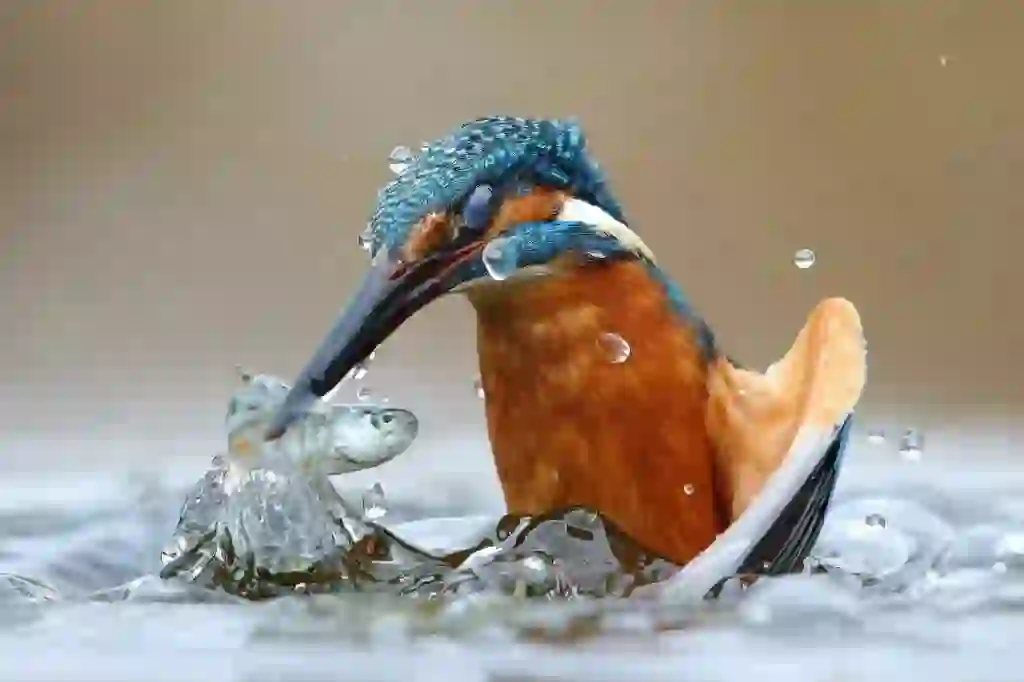
Is it true that kingfishers wear goggles when they go into the water?
The kingfisher’s staple food is fish, so it needs to catch prey that are in the water. Its long beak is a shape suitable for catching fish.
I will briefly introduce the hunting method.
First, it waits on a stone or branch near the water. If there is no suitable perch, it hovers and waits in the air.
By the way, hovering means to stop in the air. Helicopters and drones are famous, but the kingfisher can also stop in place while flapping its wings.
Then, when it finds its prey, it quickly dives into the water and grabs the fish firmly. The way it catches it in an instant is not an exaggeration to call it a master fisherman.
Also, when it dives into the water, it produces something like goggles from its eyes to accurately catch its prey even underwater. You might compare it to a swimmer or a diver.

Do kingfishers have natural enemies?
The kingfisher’s natural enemies are all kinds of carnivorous animals that target small animals. Especially snakes, weasels, and foxes are famous. They are targeted even after they become adults, but they are also often attacked when they are chicks.
Also, it has been confirmed that the kingfisher narrows its body when a predator approaches.
Some owls also narrow their body and camouflage themselves as dead trees when they feel danger, and the kingfisher does the same kind of behavior. Some people may think, “Even if you narrow your body, won’t you be exposed because of your bright colors?”
Animals’ eyes cannot distinguish colors as finely as humans, so narrowing their body can be considered camouflage. It is the same reason why the tiger’s stripes are protective colors.
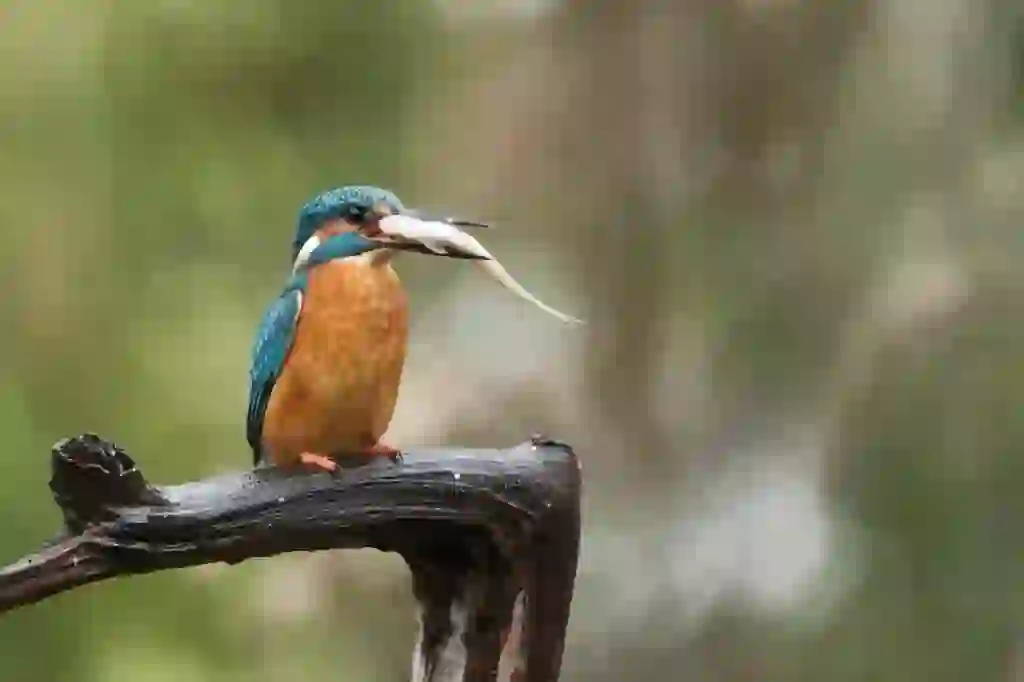
Why do kingfishers live there?
The kingfisher prefers places close to the water, but it makes its nest in steep cliffs and the like. It digs a horizontal hole to make its nest.
Why does it choose cliffs on purpose?
It is said that it is to avoid the attack of predators. Of course, I don’t think it can completely eliminate them, but it is probably a habit that the kingfisher has learned to survive in the harsh nature.
Also, the kingfisher is widely distributed worldwide, and can be seen throughout Japan. It is generally known as a resident bird that lives in the same area all year round, but in cold regions such as Hokkaido, it migrates south in winter.
The reason is that the water surface freezes in winter. Even if it is called a master fisherman, it seems that it cannot break the frozen water surface and catch its prey.

Would you like to become a part of the 'Animalbook.jp'?
Turn your knowledge into Q&A and share it with the world. ※Publication will be activated after purchase. Let's share information together!
Kingfisher Type of List
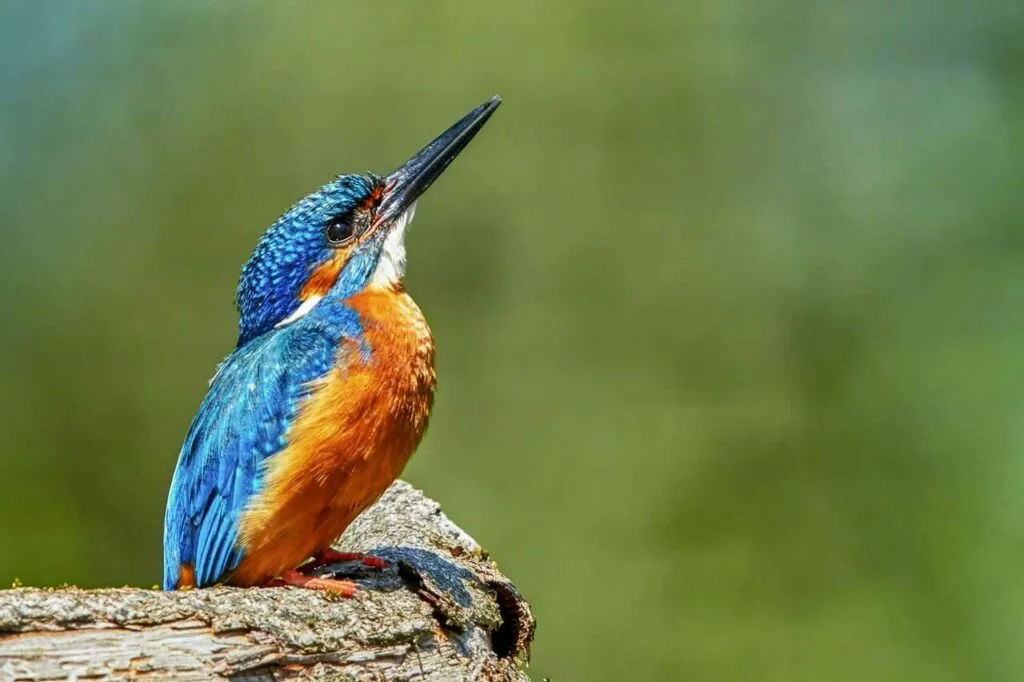
Seven subspecies of kingfishers exist.
- Alcedo atthis atthis
- Alcedo atthis ispida
- Alcedo atthis bengalensis
- Alcedo atthis taprobana
- Alcedo atthis floresiana
- Alcedo atthis hispidoides
- Alcedo atthis salomonensis
Information
Congratulations! You are the first commenter!

Create Your Favorite List!
Kingfisher
Save the animals you love! Build your own list to quickly revisit your favorites later.

Would you like to leave a comment?
※Please note: This is for the purchase of rights to post comments within the article.
Find Your Favorites!
Our shop offers a unique and attractive selection of goods themed around various animals.
Kingfisher References

- Wikipedia https://ja.wikipedia.org/wiki/カワセミ
- サントリーの愛鳥活動 https://www.suntory.co.jp/eco/birds/encyclopedia/detail/1408.html
- BIRD FAN https://www.birdfan.net/pg/kind/ord15/fam1500/spe150006/
- CANON BIRD BRANCH PROJECT https://global.canon/ja/environment/bird-branch/photo-gallery/kawasemi/index.html
- 森と水の郷あきた http://www.forest-akita.jp/data/bird/03-kawasemi/kawasemi.html
- 国土交通省 中国地方整備局 太田川河川事務所(太田川生物誌) http://www.cgr.mlit.go.jp/ootagawa/Bio/birds/index374.htm
- 鳥ペディア https://bird-pedia.com/archives/878
- Omaly's House https://blog.goo.ne.jp/rameca-omaly/e/23e1efddc0a9920dea04ce7d86462d45
Kingfisher Introduction of media used
出典:https://www.pexels.com/ja-jp/photo/5470304/

出典:https://unsplash.com/photos/JtSo8IT9W9s

出典:https://pixabay.com/images/id-3526165/

出典:https://unsplash.com/photos/ENrF-lSsdqU

出典:https://unsplash.com/photos/Pu553qm9Rbc

出典:https://unsplash.com/photos/oLrZtwSPZ3A
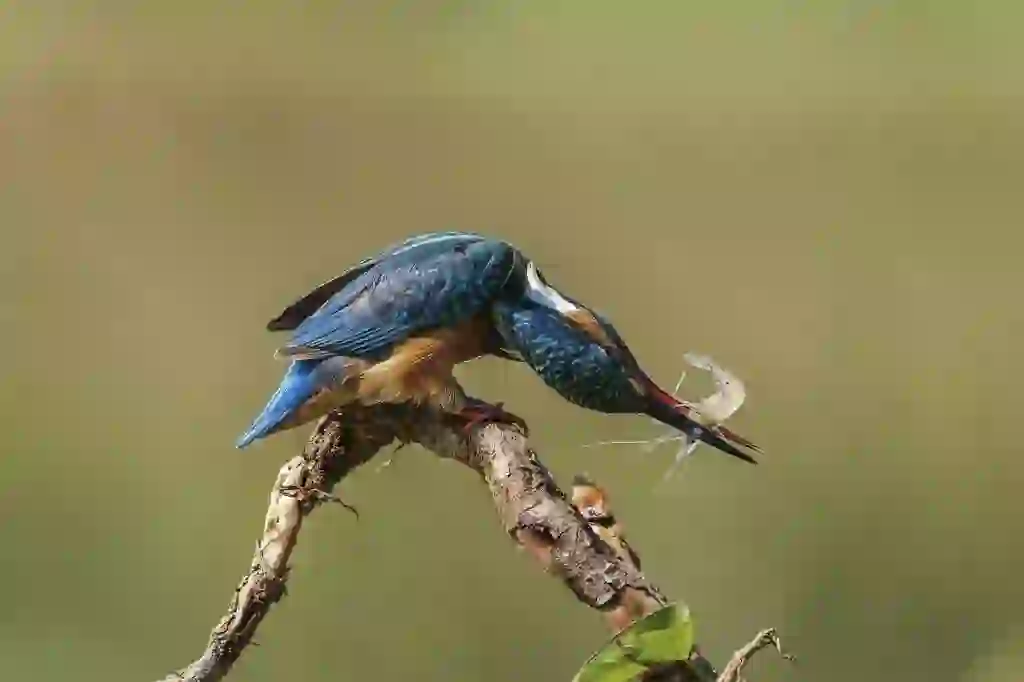
出典:https://pixabay.com/images/id-6146356/

出典:https://pixabay.com/images/id-1068480/

enemy
出典:https://commons.wikimedia.org/wiki/File:Mustela_itatsi_on_tree.JPG

enemy
出典:https://pixabay.com/images/id-1573451/

出典:https://commons.wikimedia.org/wiki/File:Alcedo_atthis_08.JPG

出典:https://pixabay.com/images/id-3270165/

Help Enrich Our Animalbook.jp with Your Media!
We are constantly looking to expand and enrich our Animalbook.jp with amazing photos and videos of animals. If you have any media that you'd like to share, please contribute and help us showcase the beauty and diversity of the animal kingdom. Your submissions will be credited and featured in our encyclopedia, reaching a wide audience of animal lovers.


















